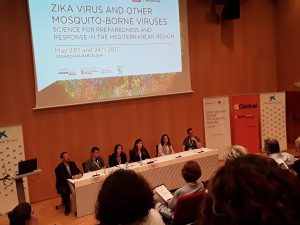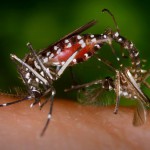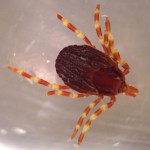Viral comments (34): A vectorial discussion, in Barcelona

A few days ago, in Barcelona, an interesting debate was held on viruses transmitted by arthropods, that is, mosquitoes and ticks among others. The debate was a B-DEBATE, from the International Center for Scientific Debate, organized by Biocat, La Caixa Foundation and Barcelona Institute of Global Health (ISGlobal) and was quite interesting. A few notes.
We have already spoken on this blog several times about vector borne diseases. Many of you are aware of Zika, Chikungunya, and the classic dengue or yellow fever virus, but we must not forget others such as West Nile fever virus or Rift Valley fever virus, or the virus of The Crimean-Congo haemorrhagic fever (transmitted by ticks that caused a death in Spain in 2016). In this debate, centered on Zika, these other aforementioned actors also appeared.
The debate was structured in several sections:
- Monitoring and prevention of infections;
- Clinical diagnosis, management (care) of patients and availability of vaccines (if the first point fails);
- The vectors or driving forces, either environmental or specifically entomological, of arboviral infections;
- The national experience (Catalonia, Greece, Algeria, Italy, France, Portugal and Lebanon) in the surveillance and control of the virus transmitted by arthropods;
- As a corollary of this, regional collaborations and collaborative networks (including the citizens’ collaboration);
- Finally, the social sciences and health economics; In other words, information management to prepare and educate the population and the obvious and hidden economic impact of epidemic outbreaks such as that of Zika on the South American continent last year.

In this debate, which accounts with a broad presence of IRTA-CReSA staff, Núria Busquets was co-chairing the session Entomology and Environmental Drives of Arboviral Infections.
In the debate, quite successful, different subjects arose.
- The need to put diseases transmitted by arthropods on the public health but also on animal health agenda in the Mediterranean countries as a result of global warming and the increasingly intense movements of goods and people (the increase in global interconnectivity). All these elements are increasing the likelihood of the arrival of such diseases; if they arrive they will have an acceptable ecosystem to settle. In fact, these outbreaks are already a reality because the local circulation of Chikungunya and dengue has already been described on the Mediterranean shores riding on the tiger mosquito, Aedes albopictus.
- There is already quite a lot of work done and research groups connected and committed. Initiatives such as MediPIET, an acronym for Further Development and Consolidation of the Mediterranean Program for Intervention Epidemiology Training, which seeks to build competent working groups in intervention epidemiology, in crisis, to control the national and cross-border challenges of infectious diseases. Initiatives such as MediLabSecure a health network for the prevention of diseases transmitted by arthropods around the Mediterranean and Black Sea regions; Infravec2 a network of infrastructures for research in vectorial biology and competence, which offer access to facilities to investigate, among other areas, the development of new control strategies; ZIKAlliance , a global network for the control and prevention of the Zika virus; ZikaPLAN , a network to fight Zika and build long-term response capabilities against other future outbreaks in Latin America, etc. What is needed is a connection between the networks to ideally cover the gaps; that information from one net serves to cover some shortcomings of a second network and the other way around. This is what COMPARE is aiming at, to a certain extent, for a multidisciplinary network to be set up as a platform for data exchange, within an analytical and global framework, for a rapid identification, containment and mitigation of emerging infectious diseases (in this case not exclusively vector-borne).
- The need to invest between outbreak episodes, in a calm situation, in entomological surveillance plans and to maintain strategies to control these vectors. This effort is not very brilliant, sparkling, mass media attractive, but is necessary, which can be complemented but not replaced by citizen collaboration (in this respect the Mosquito Alert initiative is a very good example). With good tools, a citizen network can emulate the results of institutional surveillance networks, in this case by filling gaps or warning of new detections that are later verified by professional entomologists.
- The urgent need for faster decision mechanisms. In a certain way the idea of having work teams or dormant networks that in a crisis can start working in a matter of weeks (not months) in order to have a real incidence in an outbreak. A typical example we have, again, with the outbreak of Zika. Even with the EU’s rapid response, the call for specific projects with Zika was opened when its impact on South America was high; the concession of the projects has been executed when the affectation is already minimal. Therefore, projects should work with the outbreak tail and do retrospective studies with a low direct impact, and without evaluating measures in a massive and climbing outbreak. Fieldwork in this area is no longer meaningful. Another example would be the Ebola epidemic in Guinea-Liberia-Sierra Leone, between 2014 and 2016.
- That an emergency does not drain the financing or efforts made to deal with the previous one; also that the present efforts don’t affect those for the next emergency. Zika’s case is also an example. Now many projects have been generated or have a focus on the Zika but before the Zika was dengue, which threatens more than 3 billion people, in 128 countries, which is increasing day by day its geographic range, with the obvious risk of introduction into non-endemic countries so far; which has doubled the number of apparent clinical cases between 1990 and 2013; and is increasing its incidence as a serious clinical illness, particularly in children. It can not be that paying more attention to Zika leads us to lose sight of or discontinue efforts with dengue.
- The hidden impact of vector diseases (and infectious diseases in general). There are obvious impacts on hospitalization costs, out-of-work labour costs, vector control costs, costs of monitoring and surveillance plans but there are also more hidden costs; Impact on tourism, on congresses, on domestic or international investments, and even on merchandise exports that are not related to the outbreak or its causes.
- The modelling of vector diseases, and the possibility of finding predictors of them (basically analyzing the climatic patterns that can lead to an emergence of the vector and the disease it transports).
- And finally, looking at home, an explanation of the plans for monitoring vectorial diseases in Catalonia, involving epidemiologists, entomologists, virologists, environmental health specialists, government and local government officials and primary care networks and hospitals. Between 2014 and 2016 it can be seen the impact of the Zika outbreak, because despite what some uninformed say, Catalonia is not in outer space. Of the cases confirmed in Catalonia in 2014, all imported, 81 were from Chikungunya (Chik), 51 from dengue and no cases of Zika; In 2015 were 95, 97 and 3 cases by Chik, dengue and Zika respectively, and in 2016, 150 cases of Zika, by 88 of dengue and a strong decrease of Chikungunya with only 27 cases. In this last year, 2016, the countries that contributed with more Zika imported cases in Catalonia were the Dominican Republic, Colombia, Honduras and Nicaragua … but not Brazil. Surprise? Not for me.
A debate that provided some answers but also left many questions unanswered, or with unsatisfactory answers, and this should be our goal for the next few years.
But this, this is another story.












